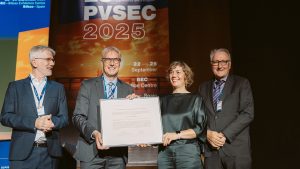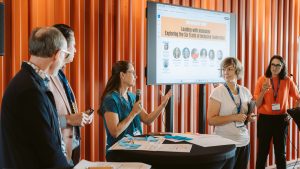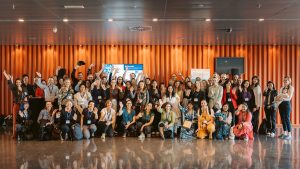Thomas Garabetian, Head of Research and Innovation at SolarPower Europe, shares highlights and lessons from the annual EU PVSEC held in September.
This year’s European Photovoltaic Energy Conference (EU PVSEC) was held from 22 to 26 September 2025 and remains a pivotal event in the solar energy sector. Bringing together an extensive network of researchers, industry leaders, and policy makers from around the world, this year’s conference showcased not only the latest advances in solar power technology, but also the dynamics of the solar power market as it evolves in response to the growing demand for sustainable energy solutions.
To explore insights and takeaways from the conference, Innovation Platform Editor Maddy Hall spoke to Thomas Garabetian, Head of Research and Innovation at SolarPower Europe.
Highlights and key points
As always, EU PVSEC attracted many participants from across the photovoltaic research community, in addition to a strong presence from industry.
One important point was the marked change in the approach of the research community. Until now, the focus has been on proving the feasibility of new technologies. The focus has now shifted to understanding how to make these technologies work commercially and how solar technology can be integrated into different business models. We are actively working not just to determine whether this technology is viable, but also how to develop commercial products that are reliable, long-lasting, and capable of generating electricity when needed. This next step is critical to growing these innovations as they need to be understood by a wider audience beyond just the solar sector. This is especially the case with perovskite solar cells. To realize the full potential of this cell technology, more funding will be needed to facilitate mass production.

In this field, the quality of installation is also attracting attention. The market appears to be stabilizing following a boom in equipment and gigawatts of capacity being installed across Europe and around the world. As a result, there is an increased focus on ensuring the quality and reliability of what is installed, along with efforts to ensure that these systems can operate reliably. The research delves into details such as how solar cells behave when exposed to ultraviolet light over a 20-year period, the integration of solar systems into the power grid, and hybridization with flexible resources such as batteries. Innovation in this area is critical to ensure that solar power systems produce stable power, remain profitable over the long term, and enable growth in this sector.
Finally, the theme of circularity is always an important topic of discussion and this year was no exception. The conference included discussions about circularity in manufacturing, particularly how to make products recyclable and implementing operating systems for sustainability that align with our focus on reliability and quality.
End-of-life considerations and material recovery are now moving from a purely theoretical discussion to a practical process. As part of the conference, we looked at how these aspects can be optimized both commercially and technically.
Plan, consider, take action
As highlighted through conferences and other recent events, one of our main priorities in the coming months will be the issue of grid integration and flexible resource deployment. Specifically, we aim to improve flexibility. This means that Europe’s battery capacity will need to increase tenfold in the coming years, and this is the central challenge of the Battery Storage Europe platform. The platform is an initiative to advance the business case and regulatory framework for battery storage across the European Union.
During the EU PVSEC, we launched a study called “Returning Solar PV Manufacturing to Europe” aimed at promoting solar PV manufacturing in Europe. This is a comprehensive report by SolarPower Europe and Fraunhofer ISE that models how solar power systems that support supply chain resilience can compete with imports from China. It also includes specific recommendations for implementing the Net Zero Industry Act.
When it comes to research innovation, collaboration is crucial. SolarPower Europe works extensively with the European Commission, the photovoltaic industry and the research community, primarily through the European Partnership for Innovation in Photovoltaics (EUPI-PV), to streamline the process of bringing innovation from the lab to the market. Our work will ensure that all stakeholders engage with the right support, skills, priorities and commitment from the private sector to translate research into tangible benefits for Europe. At this year’s EU PVSEC, we held a workshop to realize this partnership with WIP Renewables. During the session, industry players, researchers and policy makers discussed what the industry needs in terms of funding schemes to scale up innovation and how to strengthen collaboration within EUPI-PV.
Women in the PV
Part of the conference highlighted the importance of women and the impact of inclusive leadership in the solar power sector, and Walburga Hemetsberger, CEO of SolarPower Europe, was awarded the 2025 Becquerel Prize for outstanding achievements in the field of solar power. The award is given annually to an individual who has demonstrated a significant contribution to the development of solar power and recognizes Walburga’s significant achievements in leadership, championing innovation and influencing policy such as the solar energy strategy and the EU solar power standard.
Solar power is leading the way when it comes to diversity and inclusion, but there is still much work to be done.

To make the solar power sector fully accessible and open to all. Women currently make up 32% of the full-time equivalent workforce in the renewable energy sector, unchanged from 2019. Additionally, many women in the workforce work in management and support roles rather than induction and technical roles. One positive takeaway from this event, and the solar industry’s broader rollout on diversity and inclusion, is that the industry is recognizing these issues and actively working to create a more inclusive environment.
Identified issues
The conference felt less international than previous years, perhaps reflecting some of the global challenges facing the industry. The clean energy landscape in the United States is facing a particularly difficult time, making attending the conference a low priority. However, this poses challenges as the solar power sector is global in nature. Solar power technology is being deployed around the world, and international cooperation has traditionally facilitated widespread global knowledge sharing and scientific exchange. Maintaining this openness is essential, as fragmentation of our research activities risks slowing progress towards achieving energy transition goals and meeting future energy demands.

Additionally, research and innovation budgets are tightening around the world, especially in the clean energy sector, including in Europe. If we don’t invest in the technology research and innovation that will drive us through the next decade and beyond, we will have a hard time staying competitive.
Additionally, challenges such as market consolidation and flexibility, which are currently bottlenecks for solar power generation, need to be addressed. But this meeting demonstrated that this is a top priority for us as a department. We are developing effective solutions and the market appears to be increasingly willing to adopt them.
Strategic priorities for 2026 and beyond
We need to continue deploying solar PV systems at the current pace and reach the European Commission’s target of 750 gigawatts of grid-connected DC solar PV. To do this, we need to have the right infrastructure in place, including expanding the grid and accelerating the permitting process. These are currently key priorities for SolarPower Europe.
In addition to this, the company is also focused on implementing the priorities set by the European Commission and SolarPower Europe for solar PV manufacturing in Europe. The European Union has set a target of at least 30 GW of solar PV production in Europe at each stage of the value chain by 2030. Europe’s solar power industry faces a difficult market environment in order to sell and scale its products. Through our #MakeSolarEU campaign, we are driving an urgent call to support these vital links in the solar-led energy transition. By providing tools and mechanisms to support European solar manufacturers, we will enable them to contribute to the energy transition and strengthen the competitiveness of the European economy.
Ensuring adequate funding for solar innovation is essential to this. This is expected to be supported by continued cooperation and the upcoming Competitiveness Fund that the European Commission intends to introduce, in parallel with a new phase of European research and innovation funding through the Horizon Europe programme. Getting this right is critical to supporting our goals of energy transition and global competitiveness through a robust research and innovation environment.
This article will also be published in the quarterly magazine issue 24.
Source link

